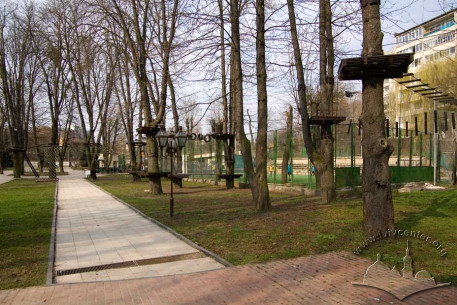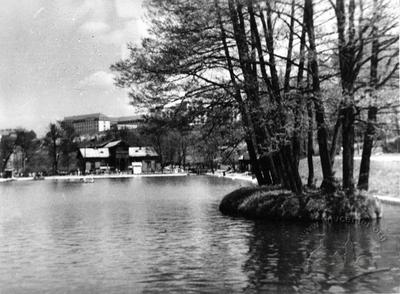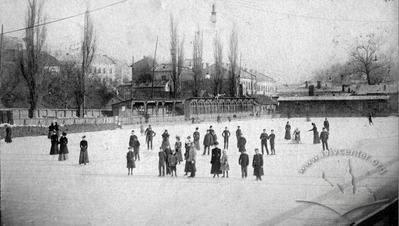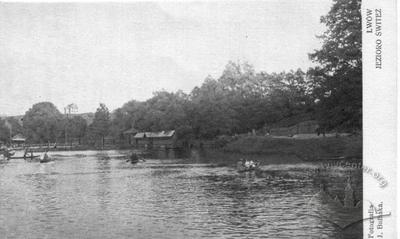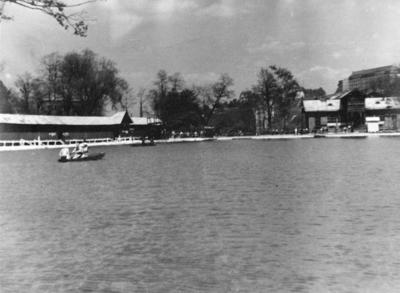Vul. Horbachevskoho, 24 – "Medyk" sport complex ID: 2167
The complex covers an area bounded on the east where Sakharov Street joins Princess Olha Street; on the west by structures along Morshynska and Pryrodna Streets; on the south by a section of land belonging to the The National Forestry and Wood-Technology University of Ukraine; and by Horbachevskyi Street on the north. The main entrance faces Horbachevskyi Street, with a service entrance from the Morshynska side. The complex has two swimming pools, tennis courts, a green for “horodky” (a national game similar to lawn bowling), play areas, and a multi-purpose sport area. The territory has been a favorite of swimmers since the beginning of the 19th century, and was named Svytiaz toward the end of the century. The facility was held in private hands until 1939; after 1945 it was transferred to the Lviv Medical Institute where its current designation - Medic - hails from. During the 1970s, the complex belonged to the Avantgarde sports club. It is currently, once again, privately-owned. A major reconstruction, designed by Yaroslav Novakivskyi, was undertaken in 1955, with renovations following in the 1990s and early 2000s.
Story
Since the start of the 19th century a pond has stood at the site registered – according to records – as private land, plot number 193 ¼ (DALO 2/1/5922:1). The Chyzhiv family owned the property until 1831, followed by the Levytskyi family (DALO 2/1/5922:12). It is from this period that the pond has been considered a swimming area. The Levytskyis held the land until 1891, after which it passed to the Yatsnitsky family, and then to Emilia Marion who named it Svytiaz (DALO 2/1/5922:33). At the outset of the 20th century, Svytiaz was run as a sports medicine complex by Marko Danek (DALO 2/1/5922:90). The Terletskyi family owned the facility from the 1920s until the outbreak of World War II (DALO 2/1/5922).
The pond was formed by the runoff from Bondarivka Creek (Vuletskyi) which flowed from the Vuletskyi Heights (the upper part of Sakharov Street), past Pelchynska Street (Vitovskyi) before reaching Stryiska Street. The pond was divided into two basins – large and small – separated by a lock. The large was designated for rowing races and the small, for swimming. The successive owners of the property were conscientious in their maintenance of the park, as they turned a good profit from its public use. Facilities were regularly updated, the territory was maintained, water levels and purity were constantly monitored, and paths to the area were kept in good order. The maintenance crew was made up of carpenters; Wojcich Fochsa, Jan Turnik, Piotr Feit – engineers; Jan Boznański, Wincenty Gorecki, Bodaszewski – builders; Leopold Fechter, Franciszek Zygmunt Leski, Oleksandr Pezhanskyi, Ludwik Sawka, Leon Legeżynski, Jan Winiarz, Władysław Śmiałowski, and Edward Mustapowicz (DALO 2/1/5922:9, 34, 49, 53, 80-82, 102, 131-132, 137, 140-144, 145-146). During the 1920s and 30s, the Rowing and Bathing Enterprise, Svytiaz was widely popular among Lvivites. (Sport, 1925, 8).
At the beginning of the 20th century, Svytiaz was a vital part of the city’s sports culture. The year 1906 saw the city’s first swimming competition (Orłowicz, 1975, 454). The large pool hosted the Seagulls and the Demigods races (Księga, 1935, 35). In 1923, the Ukraina Buyer’s Association organized a swimming competition at the facility as part of the IV Zaporizhian Games, with RomanShukhevych among the victors, (Vatseba, 1997, 91-92; Hotovi, 1935, 4-5; Trofymiak, 1997, 174). In the winter of 1926 on the small pond, ice hockey made its first appearance in Lviv (Księga, 1935, 171). After the Second World War – especially after the 1955 renovation – the complex was adapted for all-around sport use, with areas for volleyball, basketball, handball, lawn-bowling, boxing, and archery.
Architecture
The complex has managed to maintain its original purpose through the years, and currently offers activities across the territory of the park. The uppermost area was designated for handball and track and field. In the 1990s, the handball courts were refitted for archery, and since October 2011 the space has been used for paintball competitions. The lowermost area holds the swimming pools, tennis courts, and lawn-bowling pitch.
The complex has three swimming pools. The large pool, running north to south, was employed for swimming and rowing races in the summer, and for ice skating in the winter. The smaller pool was set east-west, and was the deepest of the three, used for swimming, diving, and water polo. Another pool, built apart from the others, and designed for swimming and hockey, once sat on the complex’s north side. In contrast to the other pools, it was constructed asymmetrically. It no longer exists; its place occupied by the Dacha restaurant.
Since the mid-2000s, the large swimming pool has been used as an ice rink during the winter months. There have been noises about the building of a modern sports arena, but nothing has come of it. A small island at the southern end of the pool provides an interesting compositional element to the facility. Pleasantly landscaped with a footbridge from the bank, the island holds an entertainment hall which has stopped operating only recently.
The northernmost area of the complex, with its tennis courts, bleachers, and lawn-bowling area, is surrounded by large, chain-link fence.
Located midway between the tennis courts and the main path there is now a rope & climbing adventure area. An area for bowling originally occupied the terraces, dug out from the hillocks near Morshynska Street. Over the years the area was converted to basketball and volleyball courts.
Administrative and service buildings occupy n the eastern section of the campus, near Princess Olga Street. The main entrance, with its six-columned porch, reflects the architectural tendencies of the 1950s (Yaroslav Novakivskyi, 1955). A metal gate stands at the Morshynska side entrance. The entire territory is enclosed by a fence.
People
Wojciech Fochsa, Jan Turnik, Piotr Feit, Jan Boznański, Wincenty Gorecki, Bodaszewski, Leopold Fechter, Franciszek Zygmunt Leski, Oleksandr Pezhanskyi, Ludwik Sawka, Leon Legeżyński, Jan Winiarz, Władysław Śmiałowski, Edward Mustapowicz: the architects and buildings of Svytiaz.
Emilia Marion – from 1891, the owner of the swimming area, who named
it Svytiaz.
Yaroslav Novakivskyi – architect and designer of the 1955 complex
reconstruction.
Stanisław Dutko – swimming competition organizer at Svytiaz,
1906.
Władysław Marion – oarsman from the winning Seagulls rowing
team, 1908.
Tadeusz Kuchar – competitive swimmer. 100m Free-style champion from
the 1908 Svytiaz competition.
Roman Shukhevych – backstroke champion from the 1923 IV Zaporizhia
Games, and the future General “Chuprynka” of the Ukrainian
Insurgent Army.
Volodymyr Shulhin – 1961 USSR Handball champion.
Sources
- Державний архів Львівської області (ДАЛО) 2/1/5922/153 арк.
- Вацеба Оксана, Нариси з історії спортивного руху в Західній Україні (Івано-Франківськ: Лілея-НВ, 1997), 91–92.
- Готові, 1935, Ч. 8, 4–5.
- Спорт, 1925, Липень, 8.
- Трофим’як Б., Фізичне виховання і спортивний рух у Західній Україні (з початку 30-х рр. ХІХ ст. до 1939 р.), (Київ: ІЗИН, 1997), 174.
- Księga pamiątkowa poświęcona 35-leciu działalności Lwowskiego Klubu Sportowego “Pogoń” (Lwów, 1939), 35, 171, 179.
- Orłowicz Mieczysław, Moje wspomnienia (Warszawa, 1975), 454.
